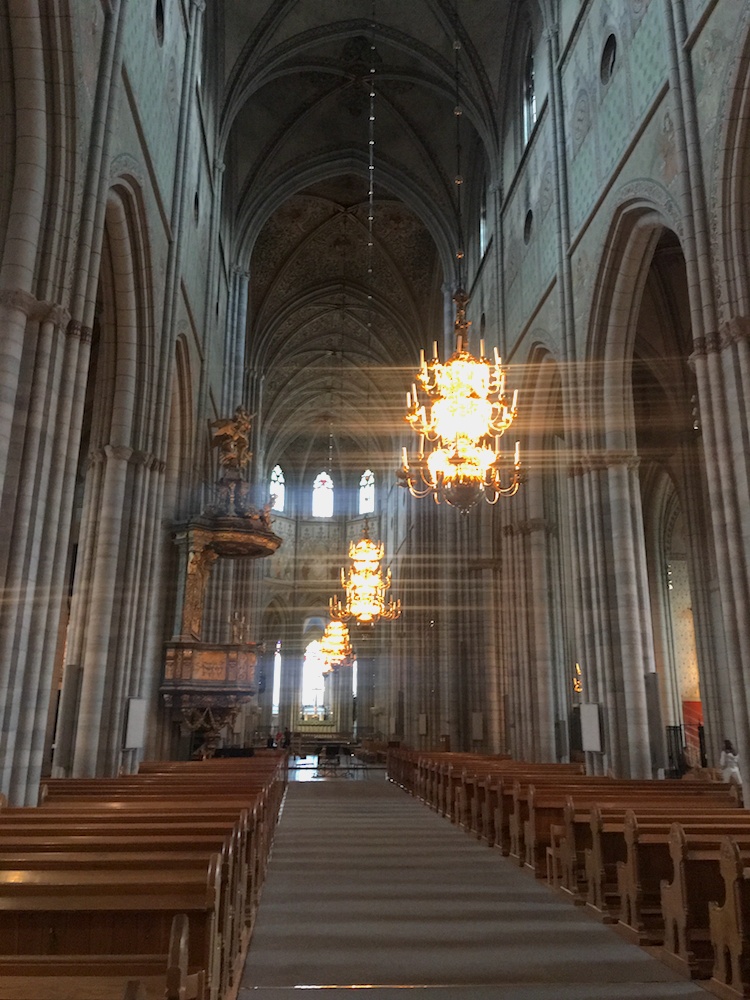


 We took a day trip to Uppsala, a university
town and Sweden's fourth largest city, located 71 kilometers
north of Stockholm. Leaving from Stockholm's central station
which was only a few blocks from where were staying, we took the
hour long train ride arriving at the Uppsala train station,
shown in the photo to the left. In addition to seeing the sights
of the town, it was a pilgrimage of sorts for Tracy, whose
maternal great grandmother hailed from here. From here we
journeyed to Uppsala's central square with the Radhuset, shown
in the photo to the right. The former city hall and
administrative seat of Uppsala municipality, it is now home to a
restaurant. From there we headed southwest on Vaksalagatan
toward the Cathedral and the university.
We took a day trip to Uppsala, a university
town and Sweden's fourth largest city, located 71 kilometers
north of Stockholm. Leaving from Stockholm's central station
which was only a few blocks from where were staying, we took the
hour long train ride arriving at the Uppsala train station,
shown in the photo to the left. In addition to seeing the sights
of the town, it was a pilgrimage of sorts for Tracy, whose
maternal great grandmother hailed from here. From here we
journeyed to Uppsala's central square with the Radhuset, shown
in the photo to the right. The former city hall and
administrative seat of Uppsala municipality, it is now home to a
restaurant. From there we headed southwest on Vaksalagatan
toward the Cathedral and the university.
 Between the hills on
which the city center and the cathedral/university reside is the
Fryris river which divides the two areas and forms a park of
sorts between the two hills. The photo to the left shows one of
several bridges that span the river, and gives a sense of the
greenery found in this urban valley. Our first destination upon
crossing the river and ascending the adjacent hill was the
Uppsala Cathedral, shown in the photo to the right. Given the
sheer verticality of the structure and the proximity of the
street, it was difficult to get a complete view of the facade.
As you can see from the photo it is an enormous structure with
twin spires and a large clock located between them. After
admiring the exterior for a moment (and to avoid the imminent
rain) we ducked inside.
Between the hills on
which the city center and the cathedral/university reside is the
Fryris river which divides the two areas and forms a park of
sorts between the two hills. The photo to the left shows one of
several bridges that span the river, and gives a sense of the
greenery found in this urban valley. Our first destination upon
crossing the river and ascending the adjacent hill was the
Uppsala Cathedral, shown in the photo to the right. Given the
sheer verticality of the structure and the proximity of the
street, it was difficult to get a complete view of the facade.
As you can see from the photo it is an enormous structure with
twin spires and a large clock located between them. After
admiring the exterior for a moment (and to avoid the imminent
rain) we ducked inside.
 Uppsala is the seat of the
Archbishop of Sweden and, for hundreds of years, the kings and
queens of Sweden were crowned here. Although construction of the
cathedral began in 1270, it was not consecrated until 1425,
nearly 200 years later. The present layout of the church dates
from its reconstruction, following the great fire of 1702. The
church is as wide as it is tall, approximately 118 meters. The
height of the ceiling above the central aisle (upper left photo)
is 26.6 meters. At the rear of the church is the Akerman organ,
the largest organ in Sweden when it was installed, and one of
two organs in the cathedral--it is pictured in the photo at the
upper right. The altar area is referred to as the "choir," and
is depicted in the photo at the bottom left. The murals depict
the the life of Jesus, the apostles, and other figures from the
history of Christianity. The altar cross was designed by Bertil
Berggren-Askentrom, and was dedicated in 1976. The chandelier
above the altar is from 1648 and is the oldest in the cathedral.
The corbels or pillar surrounding the choir
are the oldest feature preserved in the cathedral. It is
believed that these stone carvings were created by French
stonemasons at the start of the 14th century. In front of the
altar and in
Uppsala is the seat of the
Archbishop of Sweden and, for hundreds of years, the kings and
queens of Sweden were crowned here. Although construction of the
cathedral began in 1270, it was not consecrated until 1425,
nearly 200 years later. The present layout of the church dates
from its reconstruction, following the great fire of 1702. The
church is as wide as it is tall, approximately 118 meters. The
height of the ceiling above the central aisle (upper left photo)
is 26.6 meters. At the rear of the church is the Akerman organ,
the largest organ in Sweden when it was installed, and one of
two organs in the cathedral--it is pictured in the photo at the
upper right. The altar area is referred to as the "choir," and
is depicted in the photo at the bottom left. The murals depict
the the life of Jesus, the apostles, and other figures from the
history of Christianity. The altar cross was designed by Bertil
Berggren-Askentrom, and was dedicated in 1976. The chandelier
above the altar is from 1648 and is the oldest in the cathedral.
The corbels or pillar surrounding the choir
are the oldest feature preserved in the cathedral. It is
believed that these stone carvings were created by French
stonemasons at the start of the 14th century. In front of the
altar and in  the
center of the cathedral's
the
center of the cathedral's  apse
is the Vasa Chapel. It is here that King Gustav I is buried,
along with his queens, his son, and his son's queen. This is
shown in the photo at the lower right. In addition to the Vasa
Chapel, there are 10 other chapels lining the sides of the
cathedral dedicated to royalty, dignitaries, and religious
figures.
apse
is the Vasa Chapel. It is here that King Gustav I is buried,
along with his queens, his son, and his son's queen. This is
shown in the photo at the lower right. In addition to the Vasa
Chapel, there are 10 other chapels lining the sides of the
cathedral dedicated to royalty, dignitaries, and religious
figures.
| 1. Gustavianum |
2. Carolina
Rediviva |
3. Universitetshuset |
| 4. Universitetsparken |
5. Ekermanska
huset |
6. Konsistoriehuset |
 There is also a version
of this tour designed specifically for VR
headsets such as Google Cardboard, and it
works with both iPhone and Android
devices. It may be access by scanning on
the QR code to the left. If you are
viewing this on a mobile phone, you may
access the VR tour by following this
link.
There is also a version
of this tour designed specifically for VR
headsets such as Google Cardboard, and it
works with both iPhone and Android
devices. It may be access by scanning on
the QR code to the left. If you are
viewing this on a mobile phone, you may
access the VR tour by following this
link.

 The day we visited Uppsala the news broke
that a rare Viking boat burial site was unearthed in Uppsala,
the first discovery of its kind in 50 years according to
archeologists. Two Viking burial boats were unearthed in Gamla
Uppsala, Sweden — one of which was exceptionally preserved and
held the remains of a dog, a man and a horse. The graves were
uncovered during an excavation at a vicarage in Old Uppsala last
autumn. They were found beneath a cellar and a well dating from
the Middle Ages. The Vikings sent a handful of their powerful
elites to the afterlife in boats laden with sacrificed animals,
weapons and treasure; the funeral practice dates back to the
Iron Age (A.D. 550 to 800) but was used throughout the Viking
age (A.D. 800 to 1050).
The day we visited Uppsala the news broke
that a rare Viking boat burial site was unearthed in Uppsala,
the first discovery of its kind in 50 years according to
archeologists. Two Viking burial boats were unearthed in Gamla
Uppsala, Sweden — one of which was exceptionally preserved and
held the remains of a dog, a man and a horse. The graves were
uncovered during an excavation at a vicarage in Old Uppsala last
autumn. They were found beneath a cellar and a well dating from
the Middle Ages. The Vikings sent a handful of their powerful
elites to the afterlife in boats laden with sacrificed animals,
weapons and treasure; the funeral practice dates back to the
Iron Age (A.D. 550 to 800) but was used throughout the Viking
age (A.D. 800 to 1050).  These richly appointed
graves have been discovered across
Scandinavia.
For example, archaeologists had previously found one such burial
boat in Norway that had evidence of human
remains and one in western Scotland that contained a slew of
burial items such as an ax, a shield boss, a ringed pin, a
hammer and tongs. The elites who were given such elaborate
send-offs were also often buried with animals, such as
stallions. Selected parts of the discovery will be put on
display at the Gamla Uppsala Museum, Uppsala, and Stockholm's
Swedish History Museum.
These richly appointed
graves have been discovered across
Scandinavia.
For example, archaeologists had previously found one such burial
boat in Norway that had evidence of human
remains and one in western Scotland that contained a slew of
burial items such as an ax, a shield boss, a ringed pin, a
hammer and tongs. The elites who were given such elaborate
send-offs were also often buried with animals, such as
stallions. Selected parts of the discovery will be put on
display at the Gamla Uppsala Museum, Uppsala, and Stockholm's
Swedish History Museum.